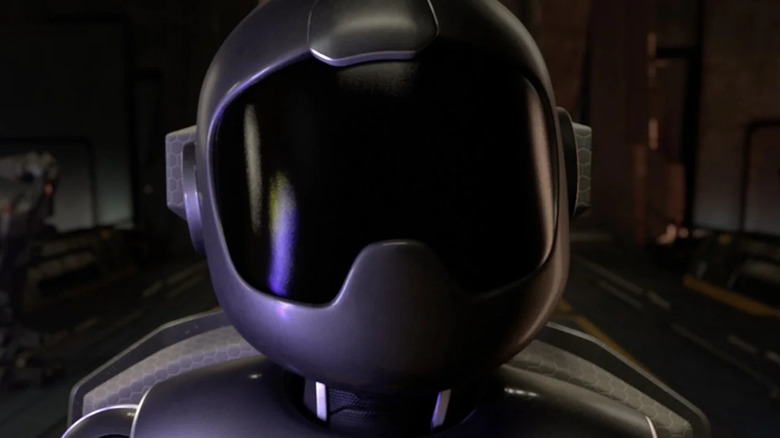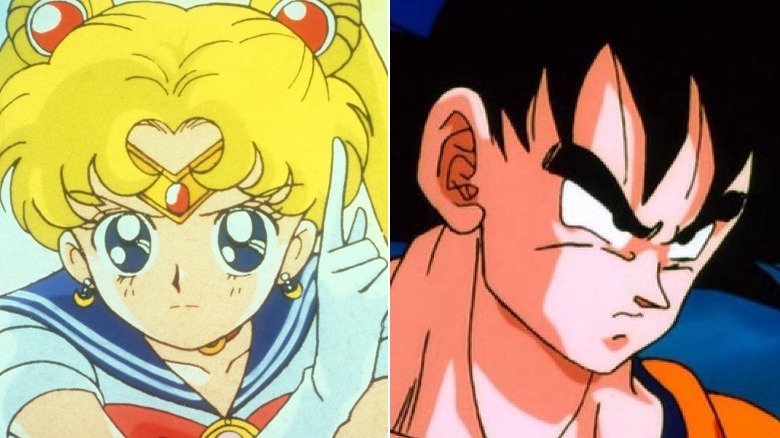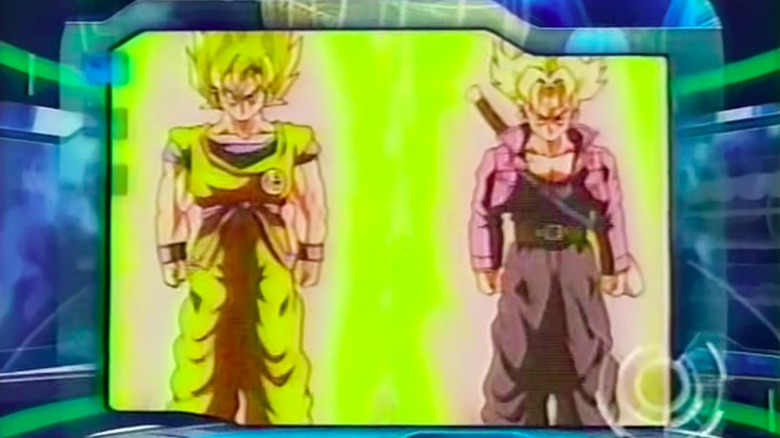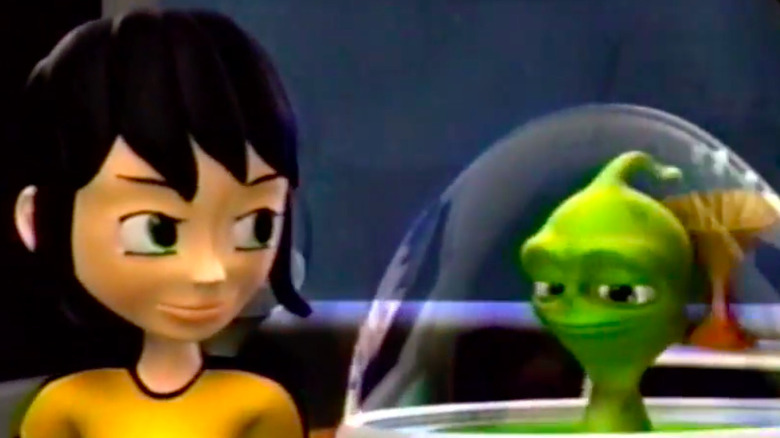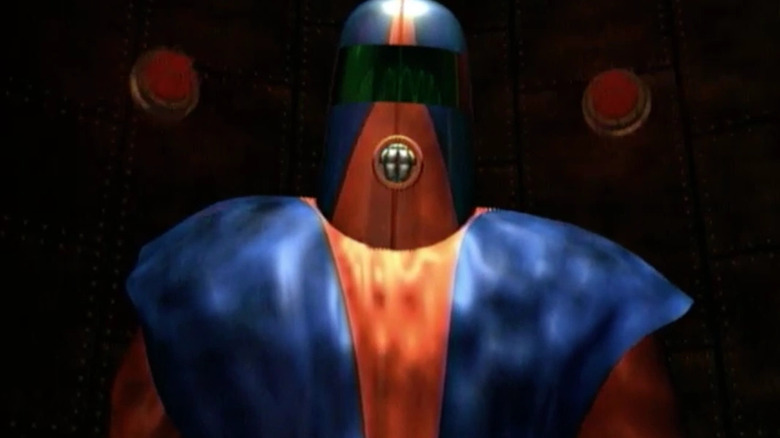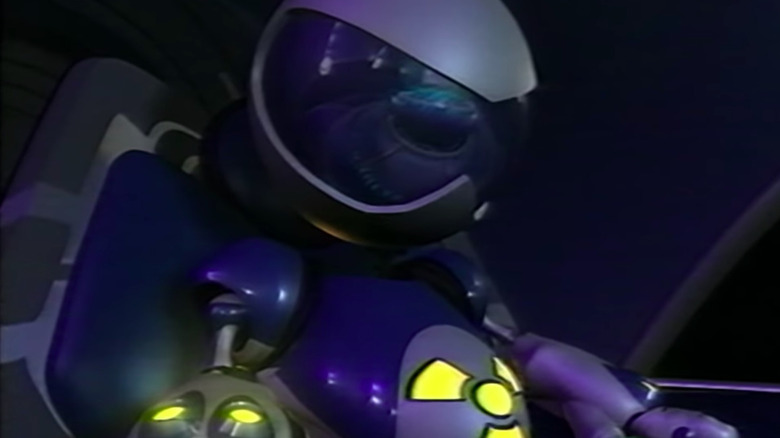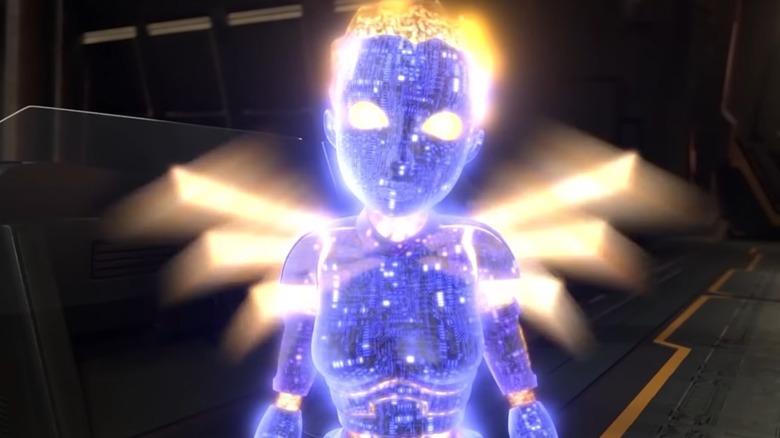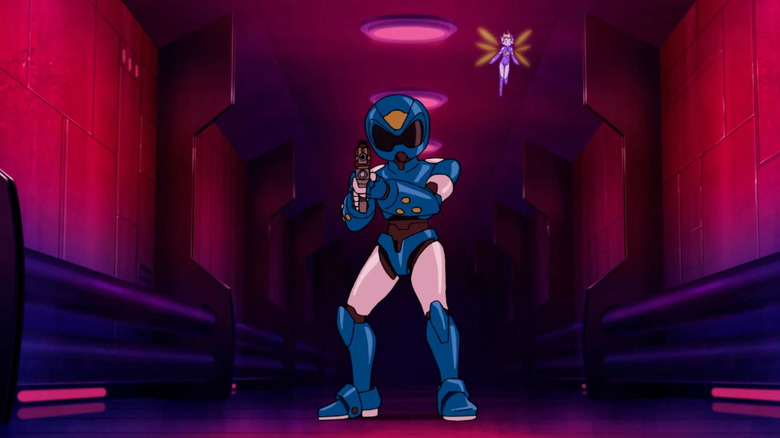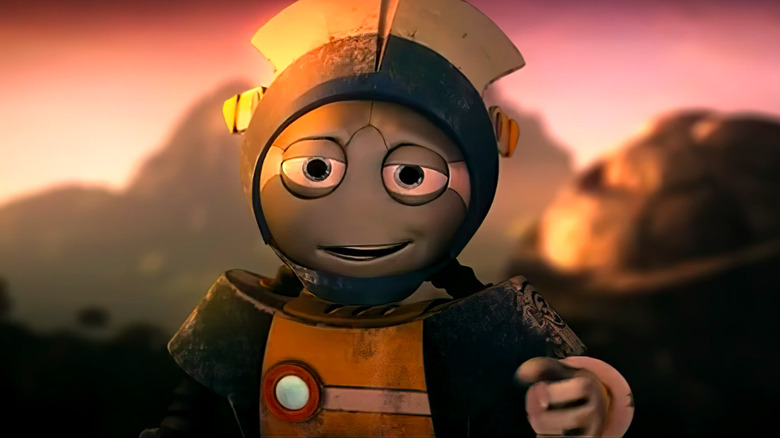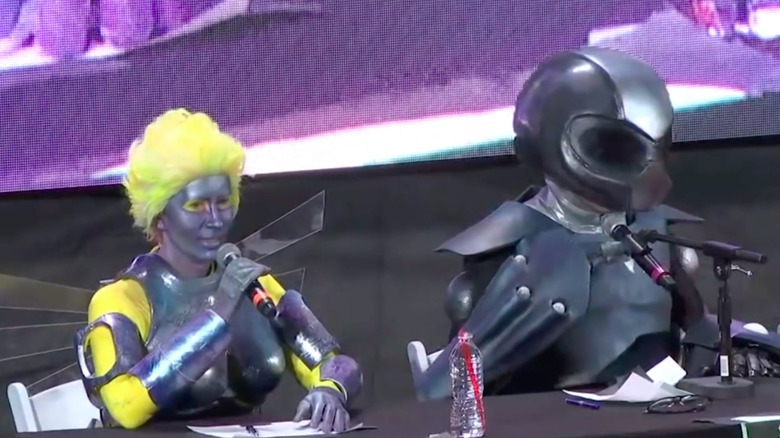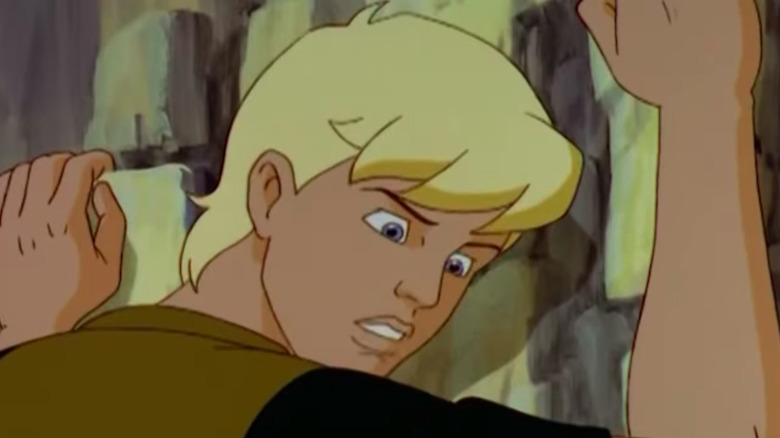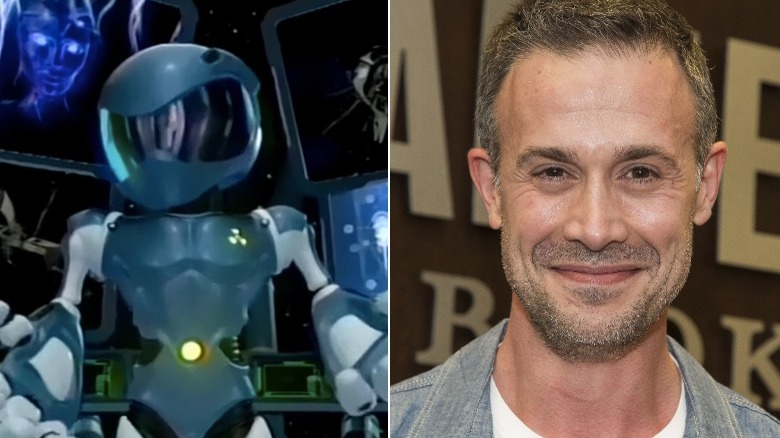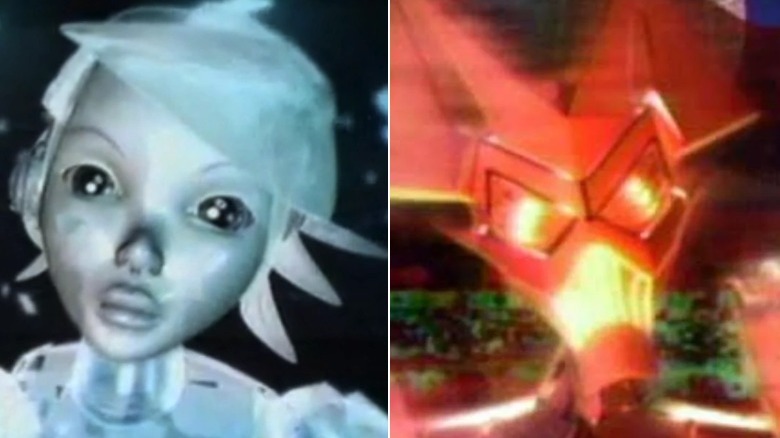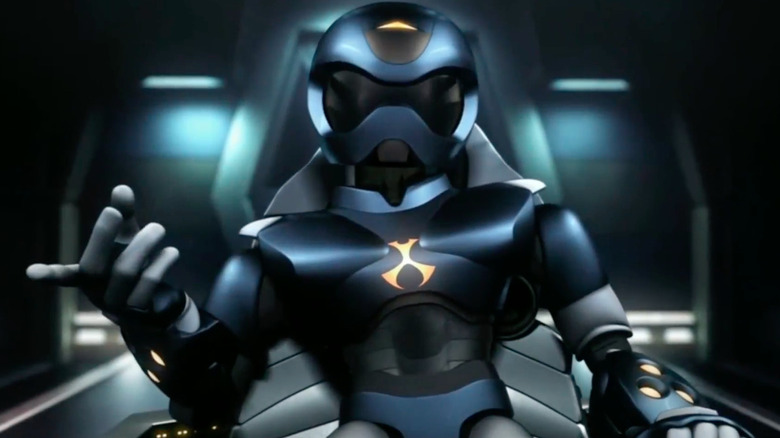The Untold Truth Of Toonami
How many action cartoon blocks can say they've been around a quarter of a century? On March 16, 2022, the televised revolution known as Toonami officially crossed the 25-year mark, an accomplishment made all the more impressive by the fact that 14 years earlier, the block nearly ended for good.
With its CGI hosts, custom cartoon introductions and heavy use of electronic, hip hop, and rave dance music for its promos and interstitials, Toonami is truly one of a kind. Though rightfully heralded for rocketing anime to the mainstream in the United States, the block is also renowned for its personal nature, with Moltar, TOM, SARA, and friends creating a rapport with viewers by offering their takes on life (not to mention the latest video games).
Toonami's longevity has earned it fans of all ages, including those who've watched from the original Cartoon Network days all the way to the Adult Swim era. Yet even among the "Toonami Faithful" (as the block's hosts often calls its viewers), there may be a few facts hidden in SARA's secret files or within the walls of Ghost Planet Industries that you're not aware of. Suit up, boot up a DOK, or hitch a ride on Clyde 49 for this Total Immersion Event: the untold truth of Toonami.
Toonami launched its creators' careers
Toonami began with Mike Lazzo, then vice president of programming for Cartoon Network; Sean Akins, Toonami's first senior writer/producer; and Jason DeMarco, also a writer and producer on the block. "It was Mike Lazzo who asked Sean for an idea to package an action block of cartoons," DeMarco told Toonami Fan. "Sean tried to make something that brought in all of the stuff he was into, like skating, comic books, music, film and anime." DeMarco was then approached by Akins, and together they set out to, as the block often reminds viewers, "build a better cartoon show."
What's truly amazing is how Toonami launched so many of its creators' careers into the stratosphere. Akins would spend 10 years as a creative director for Cartoon Network, conceiving and/or running a number of shows and cartoon blocks before his departure. DeMarco, meanwhile, has held Akins' former position as Toonami's creative director for several years, as well as a number of major positions at Cartoon Network and Adult Swim, most recently the senior vice president of anime and action series/longform for Warner Bros. Animation and Cartoon Network Studios. Similarly, Gill Austin, who originally helped bring Toonami into existence as a production assistant, eventually began running the block with DeMarco, and is currently Adult Swim's vice president/creative director of creative production. Lazzo, meanwhile, founded and ran Adult Swim until his retirement.
An anime powerhouse
Despite being part of the block since its inception, anime wasn't strongly associated with Toonami in the beginning. The first two anime series to grace Toonami's line-up, "Voltron" and "Robotech," are both mash-ups of multiple animated shows from Japan, rather than a translation of a single series. But all that changed when "Sailor Moon" joined the block.
Already a hit in multiple parts of the world, including Japan, the adventures of the Sailor Guardians rapidly catapulted to the top of Toonami charts. Years later, "Mobile Suit Gundam Wing" would overtake "Sailor Moon's" ratings, with its original video animation (OVA) "Endless Waltz" bringing in more viewers than not just nearly any Toonami series to date, but almost any show or film that had been on Cartoon Network up until that point.
Yet one show that had debuted on Toonami between "Sailor Moon" and the "Gundam Wing" series kept "Endless Waltz" squarely at number two: "Dragon Ball Z." Akins decided to bring "DBZ" to Toonami because, like other Atlanta television viewers, he had fond memories of waking up early to watch it during his childhood. While "Gundam Wing" proved a strong competitor, even its famed OVA couldn't match the numbers of "DBZ's" highest rated episodes, especially as "DBZ" continued blasting past both Toonami and Cartoon Network records during its run. From there, Toonami's viewership kept growing as more action anime joined its line-up, and the rest, as they say, is history.
Toonami's custom intros
Viewers of the modern-day Toonami are familiar with the short intros the block airs right before each series' usual title sequence, but as longtime Toonami fans know, those custom introductions not only used to be longer, but were used instead of the show's opening title. Rather than the "Cha-La Head-Cha-La" or "Rock the Dragon" intros for "Dragon Ball Z," for example, fans were instead treated to Moltar or TOM watching edited-together clips of the anime, set to music by Toonami composers and sound designers like Tommy Guerrero and Joe Boyd Vigil. Who can forget "Heavy," the tune Vigil, as he told Looper, remixed from a preexisting Guerrero track for Toonami's iconic "DBZ" Android Saga opening?
While many of these intros, along with the music that accompanies them, are deeply beloved by many Toonami viewers, a few may wonder why the block chose to replace the original introductions of the cartoons they were airing early on. As Akins explained in 2004, "We always felt that was another way to extend our brand and to own these individual shows that went into the block by giving them a 'Toonami Intro,' and then once you've made that decision, the decision to remove the opening that it comes with is sort of second nature. You don't want to see two opens back-to-back, it's just kinda silly." Akins elaborated further by saying the idea originated when he and the Toonami team found themselves unsatisfied with the title sequences of some of its first few shows.
Toonami almost had a very different host
It's likely hard for any Toonami fan to imagine the block without TOM, SARA, and Moltar at the helm. However, everyone's favorite lava man almost wasn't the one who got the ball rolling. Toonami "was originally going to have an AI and teenage girl as its hosts," but in the end, Moltar took the reigns for purely financial reasons. In a 2017 interview, Akins explained that Moltar, being a pre-existing Hanna-Barbera character and therefore owned by Cartoon Network, was free for them to use. Familiarity was also a major factor — DeMarco, who attributes Moltar's inclusion to Mike Lazzo, says "He thought that if we had a recognizable host, it would make things easier for the viewer."
That's not to say that the earlier ideas for Toonami host were never used, however. The AI idea, for instance, seems to have survived in the form of SARA, longtime co-host and companion to the block's various iterations of TOM. Similarly, Cartoon Network used a teen girl CGI host named Erin for Miguzi, Toonami's 2004 successor, when TOM and SARA permanently relocated to Saturday evenings.
Why Moltar was replaced
Given that a major reason Moltar became Toonami's first host was his recognizability, it's unsurprising that he was brought into the block essentially unchanged from his popular "Space Ghost Coast to Coast" incarnation. He was still voiced by Clay Croker and based in the Ghost Planet Industries control room, only rather than broadcasting Space Ghost's talk show, he was instead supposedly transmitting action cartoons to Earth with help from sentient robot satellite Clyde 49. Furthermore, unlike on "Coast to Coast," Moltar was 3D-computer-generated, something of a novelty for the era.
So why switch Moltar for an unknown like TOM 1? The change was conceived by Akins, as Croker's interest in Moltar's Toonami duties had waned and both Akins and DeMarco sought new creative avenues that might have been difficult to explore with Moltar.
"Until Clay Croker's passing, we never viewed TOM and Moltar as 'in universe' together," DeMarco tells Looper. Still, overlap exists between the two characters: TOM 1 introduces himself as "the new Moltar" and his ship's full name is the Ghost Planet Spaceship Absolution. Furthermore, a later Toonami segment shows TOM 3.5 (one of TOM 1's many successors) talking to both TOM 4 and Moltar, though the latter's garbled transmission partly obscures his identity. Moltar officially appears in the Toonami universe in a video honoring the late Croker, in which the lava man informs TOM 5 he's permanently returning to Planet Moltor.
The various inspirations for TOM
The original TOM, alternately TOM 1 or T.O.M. (short for Toonami Operations Module) is equal parts familiar and a departure from the host who'd come before him. Where Moltar is a being of molten lava in a black and red containment suit who works in the control room in an alien TV studio, TOM 1 is a blue and silver robot with a glowing belly and knuckles who lives in a spaceship. There are visual similarities, however, particularly in that both character designs feature helmets with visors, though TOM's is rounder and, of course, is actually his head, not just a helmet.
TOM 1's unique look stems from a number of places. As Gill Austin explains in "Toonami – 20 Years Retrospective, "The first TOM came about because Sean [Akins] had a kid robot sticker in his office that he was kind of obsessed with and he really liked the look of that." Furthermore, the official Toonami Tumblr explains that a major influence on TOM's appearance was one of the underworld cartoon scene's biggest pioneers (and the artist who gave the world the famous character Cheech Wizard), Vaughn Bodē. As for why TOM and Moltar have a "visor face," as Akins puts it in an Adult Swim interview, the Toonami co-creator explains that having characters without visible facial expressions "is the cheapest way to do animation," which was an especially important consideration in the block's early years.
The origins of SARA
SARA (voiced initially by Sally Timms and currently by Dana Swanson), originally the Absolution's sentient computer, has been greeting fans with a friendly "hello" since the early TOM 1 days. "The Intruder," Toonami's first Total Immersion Event, was the first time she'd physically appear, as a 3D holographic blue head that'd display on the screens of the Absolution. SARA — specifically SARA v1 — quickly establishes a witty repartee with TOM, cementing the beginning of a long friendship that continues to this day.
However, while SARA shows up plenty in "The Intruder," the storyline, which kills off Sonny Strait's TOM 1 and brings in Steve Blum's TOM 2, doesn't really get into SARA's backstory, nor why she hasn't showed up "in person" before. Or does it? Fans who headed over to the Toonami web site at the time "The Intruder" aired were treated to a full-on history of the character, which explained that she's an A.I. programmed to learn and experience emotion on a level on par with humans and had not been seen previously because TOM had only switched her A.I. on shortly before "The Intruder" began. The biography (now archived on SARA's Toonami wiki page) even lists her creator, Professor William Gill — a sly reference to Gill Austin.
The block almost got its own show
Much like Moltar before them, TOM and SARA have always been more than just cool-looking hosts. They're also characters with personalities and backstories who've gone on several adventures together, primarily during what are called Total Immersion Events (TIEs): brief, multi-part storylines that often contain major alterations to the Toonami status quo, e.g. TOM or SARA acquiring a new body or base (although some TIEs, such as "IGPX," are original series unrelated to the Toonami characters). In short, the two could easily anchor their own show. Steve Blum himself, who's voiced every TOM since TOM 2, has openly expressed interest, telling Toonami Faithful that he'd love to see the characters in an animated series. "I think there's enough material, there's enough history there to really pull that off," Blum says.
That wish has come one step closer to reality thanks to Toonami's latest TIEs, "Cosmo Samurai" and "Cosmo Samurai II," essentially two anime movies/insterstitials starring TOM 3 and SARA v4 set outside normal Toonami continuity (as those versions of the characters have never met). However, according to Jason DeMarco, an actual ongoing series starring the block's characters nearly did come to pass, and more than one series bible exists. As to why it hasn't happened? As DeMarco succinctly puts it, "Very hard to make a show starring a dude with no face." He's also noted that a CGI series starring the Toonami characters would be particularly expensive.
The fate of TOM 4
Remember TOM 4? According to DeMarco, TOM's smiling, blinking incarnation was conceived by Akins as an attempt to reconnect with Cartoon Network's primary viewership, since Toonami had begun attracting an older demographic. Yet the changes to TOM and the block, including swapping SARA out for the energetic, yellow TOM lookalike Flash and his mellower green counterpart, D, were controversial, to say the least. Still, this TOM lasted long enough to see Toonami through until the emotional end of its original run.
When Toonami returned in 2012, however, it wasn't TOM 4 who greeted fans, but his predecessor, TOM 3. More shocking still was the Toonami segment revealing TOM 4 existed independently of the other TOMs, rather than being an upgrade of a previous model. Furthermore, in that same video, TOM 3.5 (who is TOM 3, but upgraded) promised fans would one day learn about an untold TOM 4 adventure. In 2015, TOM 3.5's words became reality when an online comic published on Toonami's web site (now archived on the Toonami Fandom page) shows TOM 4, Flash, and D fending off a surprise attack by classic TOM nemesis the Intruder, who leaves D's body temporarily destroyed. In "The Intruder II" TIE, however, the villainous blob boasts of having destroyed TOM 5's "other self," suggesting the Intruder may have returned to finish TOM 4 off, after all.
TOM and SARA come to life
When you're a voice actor, dressing up as your character isn't usually a requirement. In some cases, neither is being in the same room. Yet never let it be said that Blum and co-star Dana Swanson aren't committed to their roles, as the two have gone to multiple San Diego Comic-Cons dressed as their Toonami characters, and clearly have had a lot of fun doing it. While Blum has primarily stuck to dressing up as TOM 5 (save for a hilarious exception where he put a cardboard box on his head and wrote "TOM 6" on it), Swanson has cosplayed as SARA v3 and SARA v4, rather cleverly getting around the fact that v3 is a head on a computer screen.
It's a great instance of seeing voice actors literally embody their characters, and it's likely a huge treat for con attendees and Toonami fans alike. Who knows? Maybe Blum and Swanson's cosplay appearances can become a backdoor pilot for a live-action Toonami series!
The show even Toonami hated
Toonami's original schedule included cartoons that first aired in the United States during the 1980s like "Thundercats" and "Voltron," along with assorted 1960s Hanna-Barbera action classics that would play during its "Cartoon Roulette" variety segment. The exception was "The Real Adventures of Jonny Quest," a 1990s modernization of the '60s kid adventurer and his world. Moltar, however, seemed lukewarm about the show, rarely using its clips to promote Toonami's line-up except when focusing on "Real Adventures" specifically or talking about something "negative," like reruns. Meanwhile, TOM 1 seemed borderline unenthusiastic about the series, culminating in a hilarious segment where he treats the show's departure from Toonami like a romantic break-up. Tellingly, when fans got to actually talk to TOM in a 1999 AOL chat, his response when asked if the show would return was succinct, but emphatic: "Absolutely not."
Turns out some of these perceived slights toward Jonny's '90s adventures were intentional. As DeMarco confirms on AskFM, "We were never given a choice to air the show, we were just told we must air it, and we didn't like it. So we subtly (and not so subtly) made our feelings known." Perhaps the most clever put-down was a Moltar-era commercial that combines a clip from "Beast Wars: Transformers" and "Real Adventures" to make it look like the Maximal Rattrap is sending Jonny Quest falling to his doom.
Freddie Prinze Jr. was almost TOM 2
While Steve Blum has an extensive voice acting career, his role as series lead Spike Spiegel on "Cowboy Bebop" will always be one of his signature performances — so much so, in fact, that it's what got him the job as Toonami's longest-running host in lieu of another major name in the acting world. "Freddie Prinze Jr. was someone Sean Akins was interested in for TOM 2," DeMarco explains to Looper. "He proved too expensive at the time. I was the one who suggested Steve Blum based on his role as Spike in Bebop."
Prinze Jr., of course, has had a number of voiceover roles over the years and performed in a few Cartoon Network and Adult Swim productions (including a memorable singing duet with Moltar's fellow Space Ghost villain, Brak). While he wasn't the voice of Toonami in the 2000s, he can be heard in Toonami's April Fools 2012 review for "Mass Effect 3" in his role as Lt. James Vega, albeit very briefly. Perhaps TOM and SARA could one day use technology swiped from the Forge to build themselves a robot voiced by Prinze they can team up with, should the stars in the Toonami universe align?
Mysteries and misconceptions
Did Samantha Robson voice SARA v2? Who played the cackling virus Swayzak in the third TIE, "Trapped in Hyperspace?" And did the first Absolution really belong to Moltar? Toonami's built up quite a few obscure mysteries over time, and fans' attempts to answer those questions haven't always been on target. DeMarco has debunked several guesses regarding Swayzak's actor, including Croker, Carl Lumbly and famed "Star Trek: The Next Generation" actor Michael Dorn. Similarly, while Robson's IMDB profile does list her as SARA 2's performer, DeMarco has cast doubt on that information, saying he's keeping the person who played SARA's second incarnation a secret.
As for who the true owner of the GPS Absolution MK I was, DeMarco leaves that answer that up to viewers. "I think Toonami fans retconned The Absolution's origins to fit that newly created plot hole, as it were," he explains to Looper, referencing a claim on the Toonami wiki's Absolution Mk. I page that Moltar indeed owned the ship. "And I'm fine with that idea!" However, DeMarco also points out Moltar isn't the person inside the Absolution who communicates with and rescues TOM in the no-longer canon comic Toonami Swarm, as the wiki's entry for the ship seems to suggest. Just whose disembodied voice was that, then? "We would prefer that remain a mystery for now!" DeMarco teases.
It's always had a strong bond with its fans
Since the beginning, Toonami has asked viewers not only to watch the block, but to become part of it. Akins, DeMarco and even TOM himself have communicated with fan sites for years, from stalwarts like The X Bridge to newer presences like Toonami Faithful and Toonami Squad. DeMarco even passed along Toonami's second album, the Black Hole Megamix, to Toonami Digital Arsenal in 2003 so fans could download it for free. Similarly, Toonami's creators usually don't mind fans uploading their promos online, as prominent Toonami archivist Junior tells Looper, and they've even sent Junior content, including several TV spots when Toonami turned 20 in 2017.
Toonami also gives fans the chance to give back to the block they love. The first TIE, "The Intruder," allowed viewers to pick the Absolution's replacement engine, while the second, "Lockdown," made a tie-in online game in which players could pilot the DOKs (armed versions of TOM and Moltar's helper robots, the Clydes), a major part of the story. Furthermore, Toonami regularly showcases fan art and even fan remasters of its old promos, such as those on Toonami Remastered. The biggest example of all, however, is likely the overwhelming response Adult Swim received when it asked viewers to use the hashtag #BringBackToonami if they wanted the block to return beyond its surprise April 1 comeback in 2012. That level of fan interaction didn't just bring Toonami back — it's what keeps Toonami going to this day.
